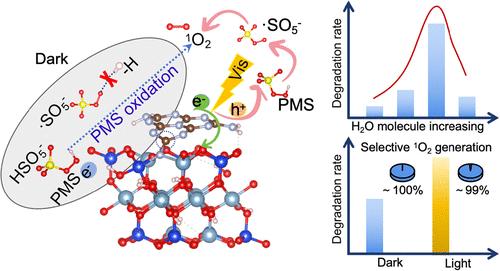水调制纳米粘土/g-C3N4异质结构在过氧单硫酸盐活化过程中选择性生成单线态氧
IF 8.2
2区 材料科学
Q1 MATERIALS SCIENCE, MULTIDISCIPLINARY
引用次数: 0
摘要
单线态氧(1O2)是一种在高级氧化过程中具有高度选择性的氧化剂,由于自由基途径的竞争,单线态氧(1O2)的产生仍然具有挑战性。在这里,我们报道了一种水调制层间约束策略,用于构建纳米粘土/g-C3N4异质结构(RT/CN),通过定制的界面电子调制促进选择性的1O2生成。在前驱体研磨过程中,通过精确调整直托石与水的比例,尿素在RT中间层内进行受限聚合,形成超薄的g-C3N4纳米片,通过Si-N-Al键共价锚定。这种不对称的界面结构诱导了局部电子再分配,使过氧单硫酸盐(PMS)通过氧化、非自由基途径激活,同时完全抑制自由基的产生。优化后的RT/CN-H3催化剂实现了双模式生成1O2:暗条件下的界面电子转移和可见光下空穴介导的增强。值得注意的是,它在黑暗条件下30分钟(k = 0.102 min - 1)内可降解96%的橙II,具有几乎完全(~ 100%)的10o2选择性。这种可扩展的无金属平台在各种污染物和环境条件下表现出强大的反应性。这项工作为利用天然矿物的层间限制建立了一种可推广的策略,对可持续氧化化学、环境补救和绿色催化系统的合理设计具有更广泛的影响。本文章由计算机程序翻译,如有差异,请以英文原文为准。

Water-Modulated Construction of Nanoclay/g-C3N4 Heterostructures for Selective Generation of Singlet Oxygen in Peroxymonosulfate Activation Processes
Singlet oxygen (1O2), a highly selective oxidant in advanced oxidation processes, remains challenging to generate efficiently and exclusively due to competing radical pathways. Here, we report a water-modulated interlayer confinement strategy for constructing nanoclay/g-C3N4 heterostructures (RT/CN) that promote selective 1O2 production through tailored interfacial electronic modulation. By precisely tuning the rectorite-to-water ratio during precursor grinding, urea undergoes confined polymerization within the RT interlayers, forming ultrathin g-C3N4 nanosheets covalently anchored via Si–N–Al linkages. This asymmetric interfacial architecture induces localized electron redistribution, enabling peroxymonosulfate (PMS) activation through an oxidative, nonradical pathway while fully suppressing radical generation. The optimized RT/CN-H3 catalyst achieves dual-mode 1O2 production: interfacial electron transfer under dark conditions and hole-mediated enhancement under visible light. Remarkably, it delivers 96% degradation of Orange II in 30 min (k = 0.102 min–1) under dark, with near-exclusive (∼100%) 1O2 selectivity. This scalable, metal-free platform demonstrates robust reactivity across diverse pollutants and environmental conditions. The work establishes a generalizable strategy for harnessing the interlayer confinement of natural minerals, with broader implications for sustainable oxidation chemistry, environmental remediation, and the rational design of green catalytic systems.
求助全文
通过发布文献求助,成功后即可免费获取论文全文。
去求助
来源期刊

ACS Applied Materials & Interfaces
工程技术-材料科学:综合
CiteScore
16.00
自引率
6.30%
发文量
4978
审稿时长
1.8 months
期刊介绍:
ACS Applied Materials & Interfaces is a leading interdisciplinary journal that brings together chemists, engineers, physicists, and biologists to explore the development and utilization of newly-discovered materials and interfacial processes for specific applications. Our journal has experienced remarkable growth since its establishment in 2009, both in terms of the number of articles published and the impact of the research showcased. We are proud to foster a truly global community, with the majority of published articles originating from outside the United States, reflecting the rapid growth of applied research worldwide.
 求助内容:
求助内容: 应助结果提醒方式:
应助结果提醒方式:


